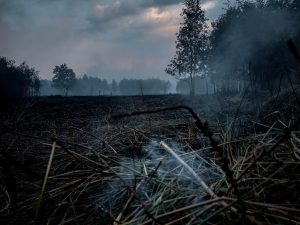Over the past two decades, Sumatra’s peatland forests have undergone a significant decline, losing approximately 3 million hectares at an annual deforestation rate averaging 150 thousand hectares. This loss can be attributed primarily to logging, forest conversion for commercial plantations, drainage for agriculture, and the utilization of fire for land clearing. Collectively, these factors have instigated peatland degradation, leading to recurrent fires, heightened carbon emissions, habitat deterioration, adverse health effects, and economic loss.
In 2015, devastating forest and peatland fires encouraged the Indonesian government to undertake progressive measures to restore and protect these crucial ecosystems. This commitment is evident in its recent reinforcement of policies and institutions, exemplified by the issuance of Government Regulation Number 57 of 2016 of the Protection and Management of Peatland Ecosystems, and the establishment of the Peatland Restoration Agency (BRGM) in 2016. Later renamed the Peatland and Mangrove Restoration Agency, the establishment of this agency signifies the government’s a concerted effort to address environmental concerns. During the period spanning from 2016 to 2020, the agency set a restoration target of approximately 2.4 million hectares of peatland. Subsequently, from 2021 to 2024, BRGM aims to restore 1.2 million hectares of peatland.
The government is employing three strategies for peatland restoration: rewetting, revegetation, and revitalization. Rewetting involves the construction of canal blocks and the drilling of wells to restore moisture to peatlands. Revegetation entails replanting hardwood trees to preserve peatland moisture and sustain the water cycle within the peatland ecosystem. Meanwhile, activities aimed at revitalizing the community’s economy seek to reduce dependency on the clearance and drainage of peatlands.
Nearly eight years after the initiation of peatland restoration policies and programs, however, multiple studies indicate that their implementation remains limited, and has failed to comprehensively reverse peatland degradation. A study conducted by Pantau Gambut, a research and advocacy network focused on peatland protection, revealed that areas designated for peatland restoration across various regions remain vulnerable to fires, notwithstanding the recent interventions.
Echoing these findings, another investigation by Greenpeace revealed that nearly one-third of the Peatland Hydrological Units in seven provinces prioritized for peatland restoration have suffered significant damage. This damage predominantly manifests in regions characterized by extensive cultivated land, numerous canals, and the granting of numerous concessions, particularly for oil palm and pulpwood plantations.
Another challenge lies in the incomplete alignment between the economic revitalization of local communities and the desired goals of peatland restoration. In many places, extractive activities, like logging and large-scale agriculture, persist, exacerbating the degradation of peatlands through drainage practices. Studies conducted in Jambi have identified resistance within communities towards restoration initiatives, notably the construction of canal blocks, which are perceived to conflict with local interests, including agricultural water usage and transportation needs.
A study conducted in Kayu Labu, South Sumatra, revealed that local farmers judiciously select commodities aligned with household socio-economic considerations, despite their discordance with long-term sustainability objectives. The study found that profit margins associated with oil palm and rubber exceed those of alternative “paludiculture” crops promoted in government-led restoration initiatives. Beyond economic advantages, additional factors such as multiplier effects, productivity gains, and enhanced market access contribute to the popularity of these commodities among farmers.
In Kampung Bunsur, Riau, the community’s economic revitalization program sought to develop the sago industry on peatlands. Despite the establishment of a sago refinery, these efforts have fallen short of expectations. The causes are multifaceted, including diminished patience among members of farmer groups, inadequate security guarantees, and inconsistent buyer availability. Consequently, the membership of farmer groups has significantly declined.
These findings underscore the disparity between government-sponsored restoration programs and the actual needs of local livelihoods. The intricate tensions within local communities residing in peatlands are frequently overlooked or misunderstood by well-intentioned policymakers, donors, or conservation groups prioritizing sustainability, consequently resulting in unsuccessful initiatives. Failing to grasp the local socio-economic dynamics and drivers behind community land use practices renders external restoration interventions ineffective.
These findings underscore the significance of aligning restoration program priorities with the actual conditions in local communities. In instances where peatland forests remain intact, there exists a promising potential to enhance recognition and accountability for indigenous communities through customary forest management schemes. However, in contexts where extractive livelihood norms prevail, commonly observed at present, the establishment of “transition pathways” assumes critical importance. These pathways necessitate collaborative efforts among governments, civil society groups, donors, and investors aimed at augmenting long-term profitability, ensuring tenure security, and enhancing local capacity for choice in conservation agriculture initiatives on restored peatlands.
It is imperative to acknowledge that this transformation demands patience and understanding, necessitating careful consideration of time allocation when formulating restoration policies and programs to prevent sporadic interventions. Moreover, such policies and programs must account for the distinctiveness of local ecosystems and adapt external technologies to leverage the longstanding potential inherent within local communities.
Ultimately, local livelihood systems should guide peatland restoration policies and programs to ensure that sustainable decisions align with the rational interests of communities. This entails actively engaging with, listening to, and empowering long-marginalized rural communities as crucial decision-makers regarding their peatlands. By integrating their objectives, requirements, and expertise, more effective protection outcomes and sustainable livelihoods can be achieved.

































